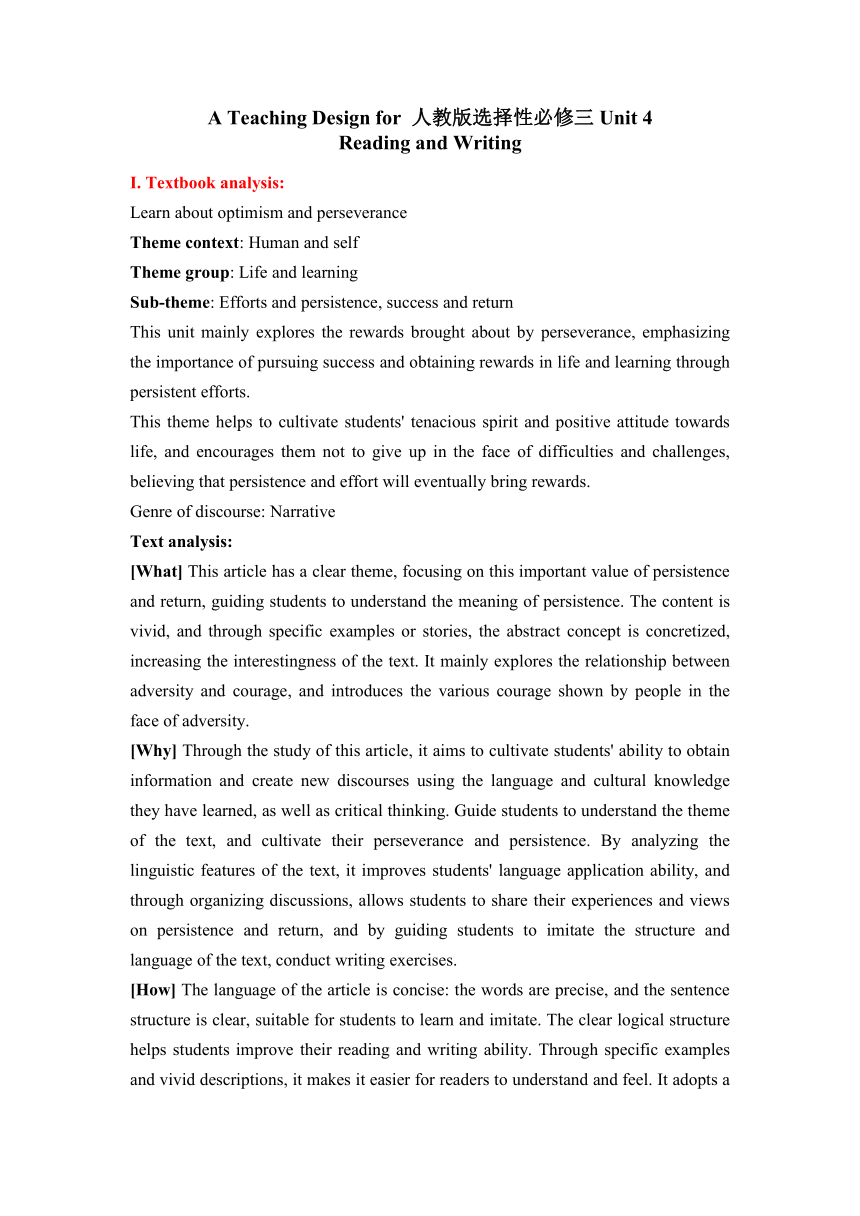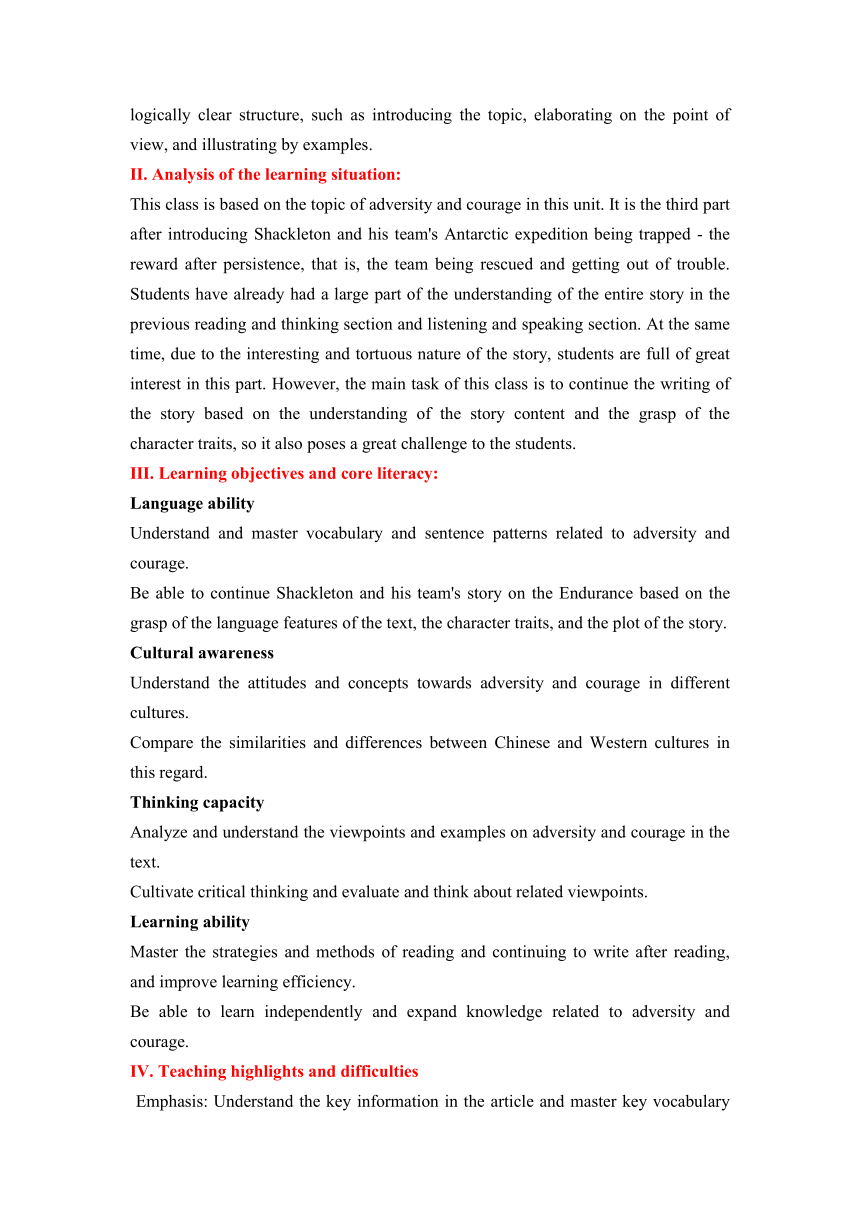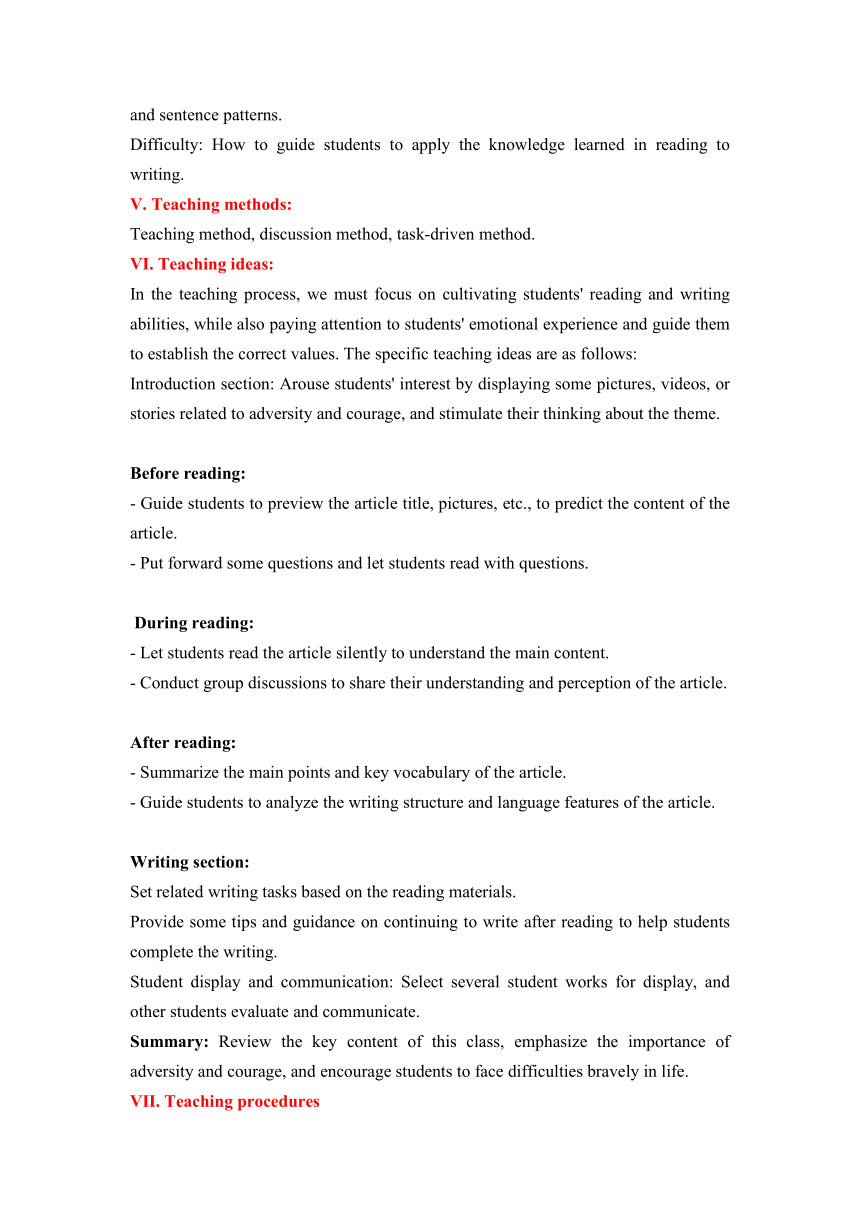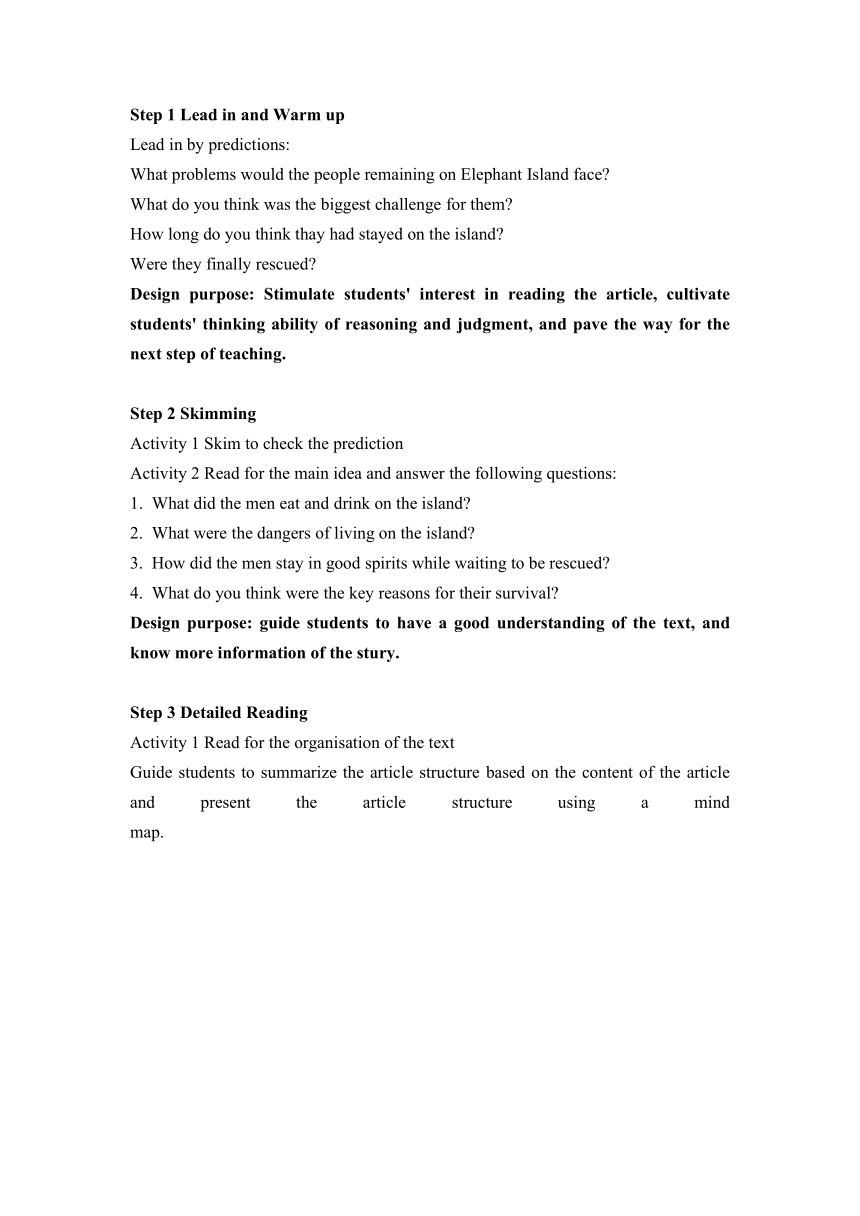人教版(2019)选择性必修第三册Unit 4 Adversity and Courage Reading and Writing教学设计
文档属性
| 名称 | 人教版(2019)选择性必修第三册Unit 4 Adversity and Courage Reading and Writing教学设计 |  | |
| 格式 | docx | ||
| 文件大小 | 189.7KB | ||
| 资源类型 | 教案 | ||
| 版本资源 | 人教版(2019) | ||
| 科目 | 英语 | ||
| 更新时间 | 2024-04-07 14:39:40 | ||
图片预览




文档简介
A Teaching Design for 人教版选择性必修三Unit 4
Reading and Writing
Ⅰ. Textbook analysis:
Learn about optimism and perseverance
Theme context: Human and self
Theme group: Life and learning
Sub-theme: Efforts and persistence, success and return
This unit mainly explores the rewards brought about by perseverance, emphasizing the importance of pursuing success and obtaining rewards in life and learning through persistent efforts.
This theme helps to cultivate students' tenacious spirit and positive attitude towards life, and encourages them not to give up in the face of difficulties and challenges, believing that persistence and effort will eventually bring rewards.
Genre of discourse: Narrative
Text analysis:
[What] This article has a clear theme, focusing on this important value of persistence and return, guiding students to understand the meaning of persistence. The content is vivid, and through specific examples or stories, the abstract concept is concretized, increasing the interestingness of the text. It mainly explores the relationship between adversity and courage, and introduces the various courage shown by people in the face of adversity.
[Why] Through the study of this article, it aims to cultivate students' ability to obtain information and create new discourses using the language and cultural knowledge they have learned, as well as critical thinking. Guide students to understand the theme of the text, and cultivate their perseverance and persistence. By analyzing the linguistic features of the text, it improves students' language application ability, and through organizing discussions, allows students to share their experiences and views on persistence and return, and by guiding students to imitate the structure and language of the text, conduct writing exercises.
[How] The language of the article is concise: the words are precise, and the sentence structure is clear, suitable for students to learn and imitate. The clear logical structure helps students improve their reading and writing ability. Through specific examples and vivid descriptions, it makes it easier for readers to understand and feel. It adopts a logically clear structure, such as introducing the topic, elaborating on the point of view, and illustrating by examples.
Ⅱ. Analysis of the learning situation:
This class is based on the topic of adversity and courage in this unit. It is the third part after introducing Shackleton and his team's Antarctic expedition being trapped - the reward after persistence, that is, the team being rescued and getting out of trouble. Students have already had a large part of the understanding of the entire story in the previous reading and thinking section and listening and speaking section. At the same time, due to the interesting and tortuous nature of the story, students are full of great interest in this part. However, the main task of this class is to continue the writing of the story based on the understanding of the story content and the grasp of the character traits, so it also poses a great challenge to the students.
Ⅲ. Learning objectives and core literacy:
Language ability
Understand and master vocabulary and sentence patterns related to adversity and courage.
Be able to continue Shackleton and his team's story on the Endurance based on the grasp of the language features of the text, the character traits, and the plot of the story.
Cultural awareness
Understand the attitudes and concepts towards adversity and courage in different cultures.
Compare the similarities and differences between Chinese and Western cultures in this regard.
Thinking capacity
Analyze and understand the viewpoints and examples on adversity and courage in the text.
Cultivate critical thinking and evaluate and think about related viewpoints.
Learning ability
Master the strategies and methods of reading and continuing to write after reading, and improve learning efficiency.
Be able to learn independently and expand knowledge related to adversity and courage.
Ⅳ. Teaching highlights and difficulties
Emphasis: Understand the key information in the article and master key vocabulary and sentence patterns.
Difficulty: How to guide students to apply the knowledge learned in reading to writing.
Ⅴ. Teaching methods:
Teaching method, discussion method, task-driven method.
Ⅵ. Teaching ideas:
In the teaching process, we must focus on cultivating students' reading and writing abilities, while also paying attention to students' emotional experience and guide them to establish the correct values. The specific teaching ideas are as follows:
Introduction section: Arouse students' interest by displaying some pictures, videos, or stories related to adversity and courage, and stimulate their thinking about the theme.
Before reading:
- Guide students to preview the article title, pictures, etc., to predict the content of the article.
- Put forward some questions and let students read with questions.
During reading:
- Let students read the article silently to understand the main content.
- Conduct group discussions to share their understanding and perception of the article.
After reading:
- Summarize the main points and key vocabulary of the article.
- Guide students to analyze the writing structure and language features of the article.
Writing section:
Set related writing tasks based on the reading materials.
Provide some tips and guidance on continuing to write after reading to help students complete the writing.
Student display and communication: Select several student works for display, and other students evaluate and communicate.
Summary: Review the key content of this class, emphasize the importance of adversity and courage, and encourage students to face difficulties bravely in life.
Ⅶ. Teaching procedures
Step 1 Lead in and Warm up
Lead in by predictions:
What problems would the people remaining on Elephant Island face
What do you think was the biggest challenge for them
How long do you think thay had stayed on the island
Were they finally rescued
Design purpose: Stimulate students' interest in reading the article, cultivate students' thinking ability of reasoning and judgment, and pave the way for the next step of teaching.
Step 2 Skimming
Activity 1 Skim to check the prediction
Activity 2 Read for the main idea and answer the following questions:
What did the men eat and drink on the island
What were the dangers of living on the island
How did the men stay in good spirits while waiting to be rescued
What do you think were the key reasons for their survival
Design purpose: guide students to have a good understanding of the text, and know more information of the stury.
Step 3 Detailed Reading
Activity 1 Read for the organisation of the text
Guide students to summarize the article structure based on the content of the article and present the article structure using a mind map.
Design intention: Help students better understand the structure and logic of the article, and improve their ability to organize and present information.
Activity 2 Read and Discussion
Read the text again and talk about the following questions:
How would you describe Shackleton Why
What qualities of Shackleton make you trust him or not trust him
If you were Shackleton, what would you do
Design intention: Stimulate students' thinking and expression abilities, and allow them to further understand the characters and events in the article.
Activity 3 Read and Sort
Lead students to review the story contents learned in the first two parts, combine with this article to organize the entire event information, and complete the following form.
Struggles Actions in response Motives Members involved My feelings and comments
Shipwreck ●Rescure most essential supplies ●Throw away personal belongs To survive Everyone on the ship ●Shackleton was a very calm and experienced explorer and leader. ●The crew kept good discipline.
Activity 4 Share and check the answers.
Design intention: Help students sort out and integrate the information of the entire event.
Step 4 Writing
Based on the diary entries and the memoir you have read, write an essay about the story of Shackleton and his men on the ship Endurance.
Activity 1 Read and Think
Read the story again and think about the following questions. Make notes with your answers.
●How does the author describe Shackleton and his crew members
●What kind of relationship did Shackleton have with his crew
● What struggles did they face
●What were the motives for their actions
● What did you like most about the story
Design intention: Help students better understand the content of the story and prepare for the subsequent writing.
Activity 2 Sorting put information of the story
Begin your essay with a brief summary of the story. Remember to include who , what , where , when , why , and how .
Use your notes and cite examples to explain what you think about the characters .
End your essay by talking about how the story made you feel , and give your overall impressions of the expedition and the men who went on it . Explain why you feel this way .
Design intention: Guide students to organize and sort out the writing materials.
Activity 3 Outline Making
Discuss with your partner based on all the previously sorted information and draft the outline of the article.
Paragraph 1 Summary of the whole story(who, what, when, where, why, how)
Paragraph 2 What I think about the characters in the story.
Paragraph 3 How the story made me feel and my overall impressions of the expedition.
Design intention: Help students form a clear writing structure.
Activity 4 Draft Making
Based on the above outline and all integrated information, complete the writing independently.
Design intention: Allow students to practice and apply the writing skills they have learned.
Activity 5 Read and Evaluate
Exchange drafts with a partner . Use the checklist to give feedback on your partner ' s draft .
√ Does the essay contain the main points in the story
√ Is the essay written in the writer ' s own words
√ Does the writer give his / her opinion about the story
√ Does the writer present his / her ideas clearly by using linking words and phrases
Design intention: Enable students to evaluate and improve their writing skills through mutual evaluation.
Activity 6 Get your draft back and revise it .
Design intention: Allow students to further improve and perfect their writing.
Step 5 Summary and Assignment
Ⅷ. Teaching Reflections:
Through this lesson, students have a deeper understanding of adversity and courage, and their reading and writing skills have also been improved to a certain extent. However, in the teaching process, attention should be paid to adjusting the difficulty and progress of teaching according to the actual situation of the students to ensure that every student can gain something.
Reading and Writing
Ⅰ. Textbook analysis:
Learn about optimism and perseverance
Theme context: Human and self
Theme group: Life and learning
Sub-theme: Efforts and persistence, success and return
This unit mainly explores the rewards brought about by perseverance, emphasizing the importance of pursuing success and obtaining rewards in life and learning through persistent efforts.
This theme helps to cultivate students' tenacious spirit and positive attitude towards life, and encourages them not to give up in the face of difficulties and challenges, believing that persistence and effort will eventually bring rewards.
Genre of discourse: Narrative
Text analysis:
[What] This article has a clear theme, focusing on this important value of persistence and return, guiding students to understand the meaning of persistence. The content is vivid, and through specific examples or stories, the abstract concept is concretized, increasing the interestingness of the text. It mainly explores the relationship between adversity and courage, and introduces the various courage shown by people in the face of adversity.
[Why] Through the study of this article, it aims to cultivate students' ability to obtain information and create new discourses using the language and cultural knowledge they have learned, as well as critical thinking. Guide students to understand the theme of the text, and cultivate their perseverance and persistence. By analyzing the linguistic features of the text, it improves students' language application ability, and through organizing discussions, allows students to share their experiences and views on persistence and return, and by guiding students to imitate the structure and language of the text, conduct writing exercises.
[How] The language of the article is concise: the words are precise, and the sentence structure is clear, suitable for students to learn and imitate. The clear logical structure helps students improve their reading and writing ability. Through specific examples and vivid descriptions, it makes it easier for readers to understand and feel. It adopts a logically clear structure, such as introducing the topic, elaborating on the point of view, and illustrating by examples.
Ⅱ. Analysis of the learning situation:
This class is based on the topic of adversity and courage in this unit. It is the third part after introducing Shackleton and his team's Antarctic expedition being trapped - the reward after persistence, that is, the team being rescued and getting out of trouble. Students have already had a large part of the understanding of the entire story in the previous reading and thinking section and listening and speaking section. At the same time, due to the interesting and tortuous nature of the story, students are full of great interest in this part. However, the main task of this class is to continue the writing of the story based on the understanding of the story content and the grasp of the character traits, so it also poses a great challenge to the students.
Ⅲ. Learning objectives and core literacy:
Language ability
Understand and master vocabulary and sentence patterns related to adversity and courage.
Be able to continue Shackleton and his team's story on the Endurance based on the grasp of the language features of the text, the character traits, and the plot of the story.
Cultural awareness
Understand the attitudes and concepts towards adversity and courage in different cultures.
Compare the similarities and differences between Chinese and Western cultures in this regard.
Thinking capacity
Analyze and understand the viewpoints and examples on adversity and courage in the text.
Cultivate critical thinking and evaluate and think about related viewpoints.
Learning ability
Master the strategies and methods of reading and continuing to write after reading, and improve learning efficiency.
Be able to learn independently and expand knowledge related to adversity and courage.
Ⅳ. Teaching highlights and difficulties
Emphasis: Understand the key information in the article and master key vocabulary and sentence patterns.
Difficulty: How to guide students to apply the knowledge learned in reading to writing.
Ⅴ. Teaching methods:
Teaching method, discussion method, task-driven method.
Ⅵ. Teaching ideas:
In the teaching process, we must focus on cultivating students' reading and writing abilities, while also paying attention to students' emotional experience and guide them to establish the correct values. The specific teaching ideas are as follows:
Introduction section: Arouse students' interest by displaying some pictures, videos, or stories related to adversity and courage, and stimulate their thinking about the theme.
Before reading:
- Guide students to preview the article title, pictures, etc., to predict the content of the article.
- Put forward some questions and let students read with questions.
During reading:
- Let students read the article silently to understand the main content.
- Conduct group discussions to share their understanding and perception of the article.
After reading:
- Summarize the main points and key vocabulary of the article.
- Guide students to analyze the writing structure and language features of the article.
Writing section:
Set related writing tasks based on the reading materials.
Provide some tips and guidance on continuing to write after reading to help students complete the writing.
Student display and communication: Select several student works for display, and other students evaluate and communicate.
Summary: Review the key content of this class, emphasize the importance of adversity and courage, and encourage students to face difficulties bravely in life.
Ⅶ. Teaching procedures
Step 1 Lead in and Warm up
Lead in by predictions:
What problems would the people remaining on Elephant Island face
What do you think was the biggest challenge for them
How long do you think thay had stayed on the island
Were they finally rescued
Design purpose: Stimulate students' interest in reading the article, cultivate students' thinking ability of reasoning and judgment, and pave the way for the next step of teaching.
Step 2 Skimming
Activity 1 Skim to check the prediction
Activity 2 Read for the main idea and answer the following questions:
What did the men eat and drink on the island
What were the dangers of living on the island
How did the men stay in good spirits while waiting to be rescued
What do you think were the key reasons for their survival
Design purpose: guide students to have a good understanding of the text, and know more information of the stury.
Step 3 Detailed Reading
Activity 1 Read for the organisation of the text
Guide students to summarize the article structure based on the content of the article and present the article structure using a mind map.
Design intention: Help students better understand the structure and logic of the article, and improve their ability to organize and present information.
Activity 2 Read and Discussion
Read the text again and talk about the following questions:
How would you describe Shackleton Why
What qualities of Shackleton make you trust him or not trust him
If you were Shackleton, what would you do
Design intention: Stimulate students' thinking and expression abilities, and allow them to further understand the characters and events in the article.
Activity 3 Read and Sort
Lead students to review the story contents learned in the first two parts, combine with this article to organize the entire event information, and complete the following form.
Struggles Actions in response Motives Members involved My feelings and comments
Shipwreck ●Rescure most essential supplies ●Throw away personal belongs To survive Everyone on the ship ●Shackleton was a very calm and experienced explorer and leader. ●The crew kept good discipline.
Activity 4 Share and check the answers.
Design intention: Help students sort out and integrate the information of the entire event.
Step 4 Writing
Based on the diary entries and the memoir you have read, write an essay about the story of Shackleton and his men on the ship Endurance.
Activity 1 Read and Think
Read the story again and think about the following questions. Make notes with your answers.
●How does the author describe Shackleton and his crew members
●What kind of relationship did Shackleton have with his crew
● What struggles did they face
●What were the motives for their actions
● What did you like most about the story
Design intention: Help students better understand the content of the story and prepare for the subsequent writing.
Activity 2 Sorting put information of the story
Begin your essay with a brief summary of the story. Remember to include who , what , where , when , why , and how .
Use your notes and cite examples to explain what you think about the characters .
End your essay by talking about how the story made you feel , and give your overall impressions of the expedition and the men who went on it . Explain why you feel this way .
Design intention: Guide students to organize and sort out the writing materials.
Activity 3 Outline Making
Discuss with your partner based on all the previously sorted information and draft the outline of the article.
Paragraph 1 Summary of the whole story(who, what, when, where, why, how)
Paragraph 2 What I think about the characters in the story.
Paragraph 3 How the story made me feel and my overall impressions of the expedition.
Design intention: Help students form a clear writing structure.
Activity 4 Draft Making
Based on the above outline and all integrated information, complete the writing independently.
Design intention: Allow students to practice and apply the writing skills they have learned.
Activity 5 Read and Evaluate
Exchange drafts with a partner . Use the checklist to give feedback on your partner ' s draft .
√ Does the essay contain the main points in the story
√ Is the essay written in the writer ' s own words
√ Does the writer give his / her opinion about the story
√ Does the writer present his / her ideas clearly by using linking words and phrases
Design intention: Enable students to evaluate and improve their writing skills through mutual evaluation.
Activity 6 Get your draft back and revise it .
Design intention: Allow students to further improve and perfect their writing.
Step 5 Summary and Assignment
Ⅷ. Teaching Reflections:
Through this lesson, students have a deeper understanding of adversity and courage, and their reading and writing skills have also been improved to a certain extent. However, in the teaching process, attention should be paid to adjusting the difficulty and progress of teaching according to the actual situation of the students to ensure that every student can gain something.
